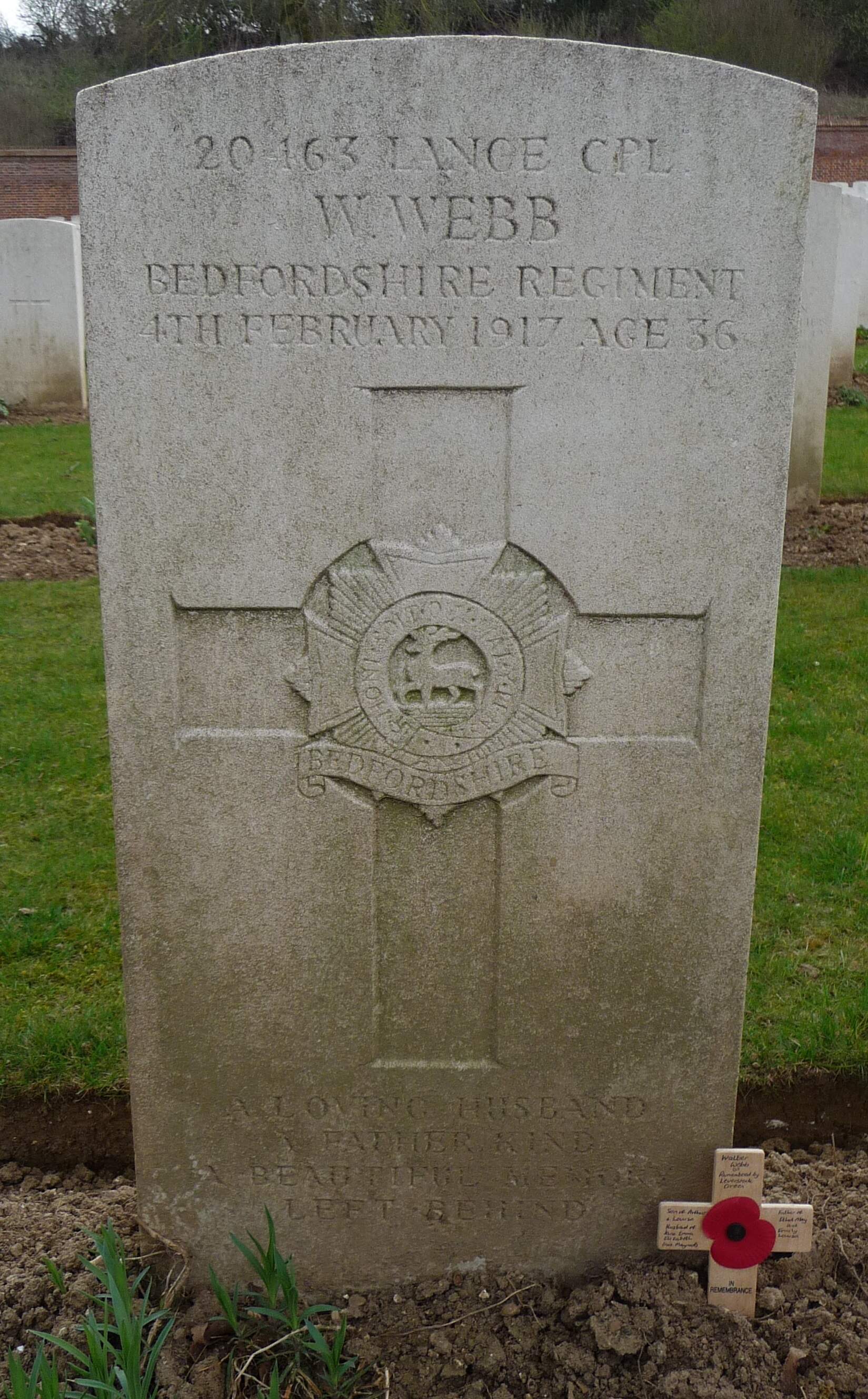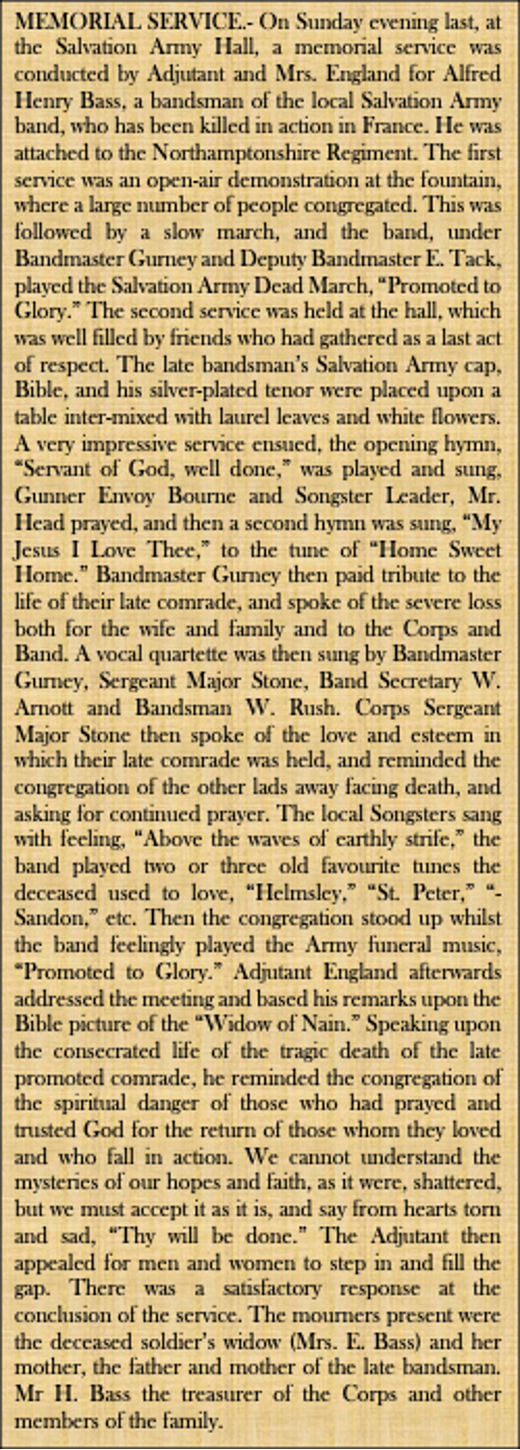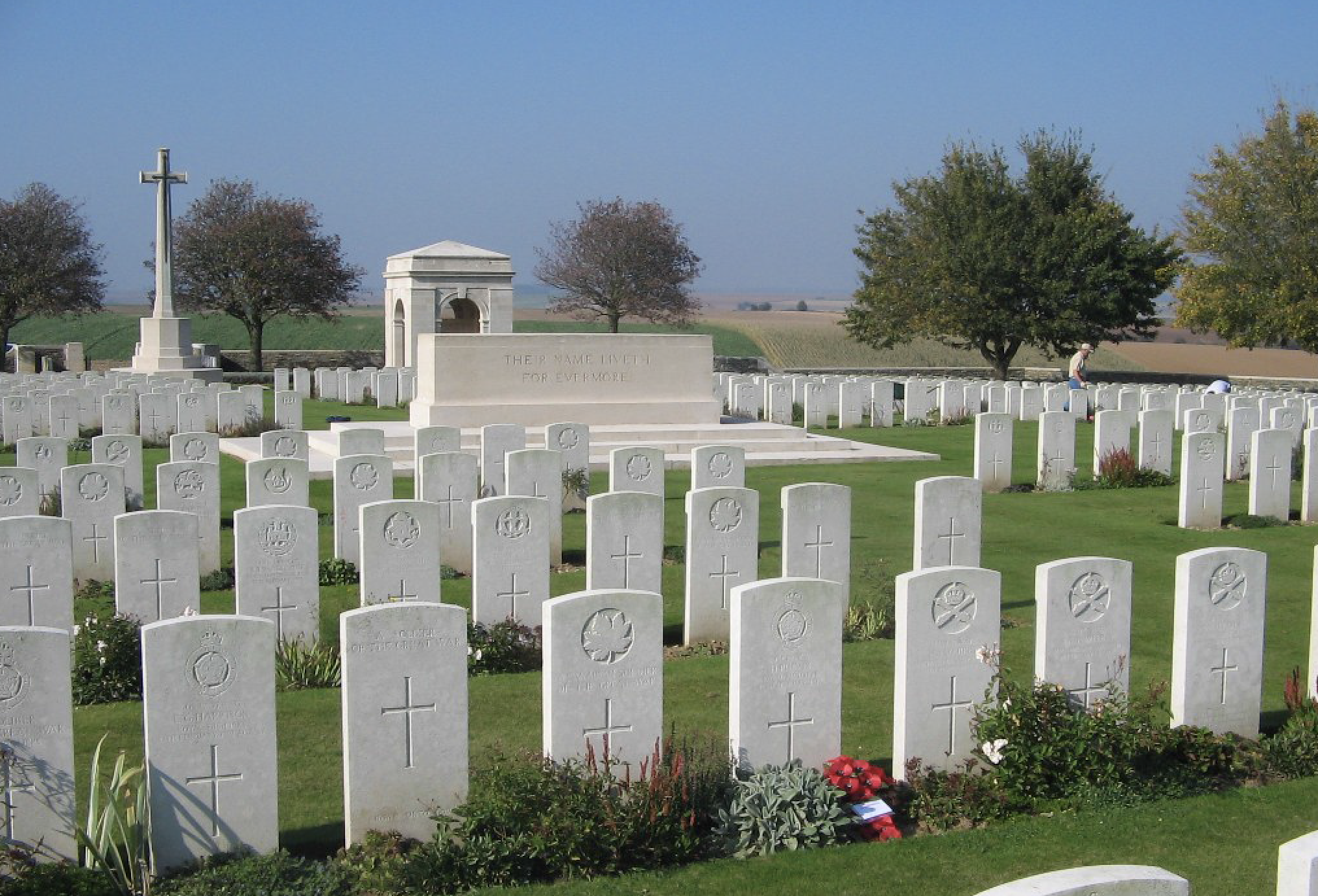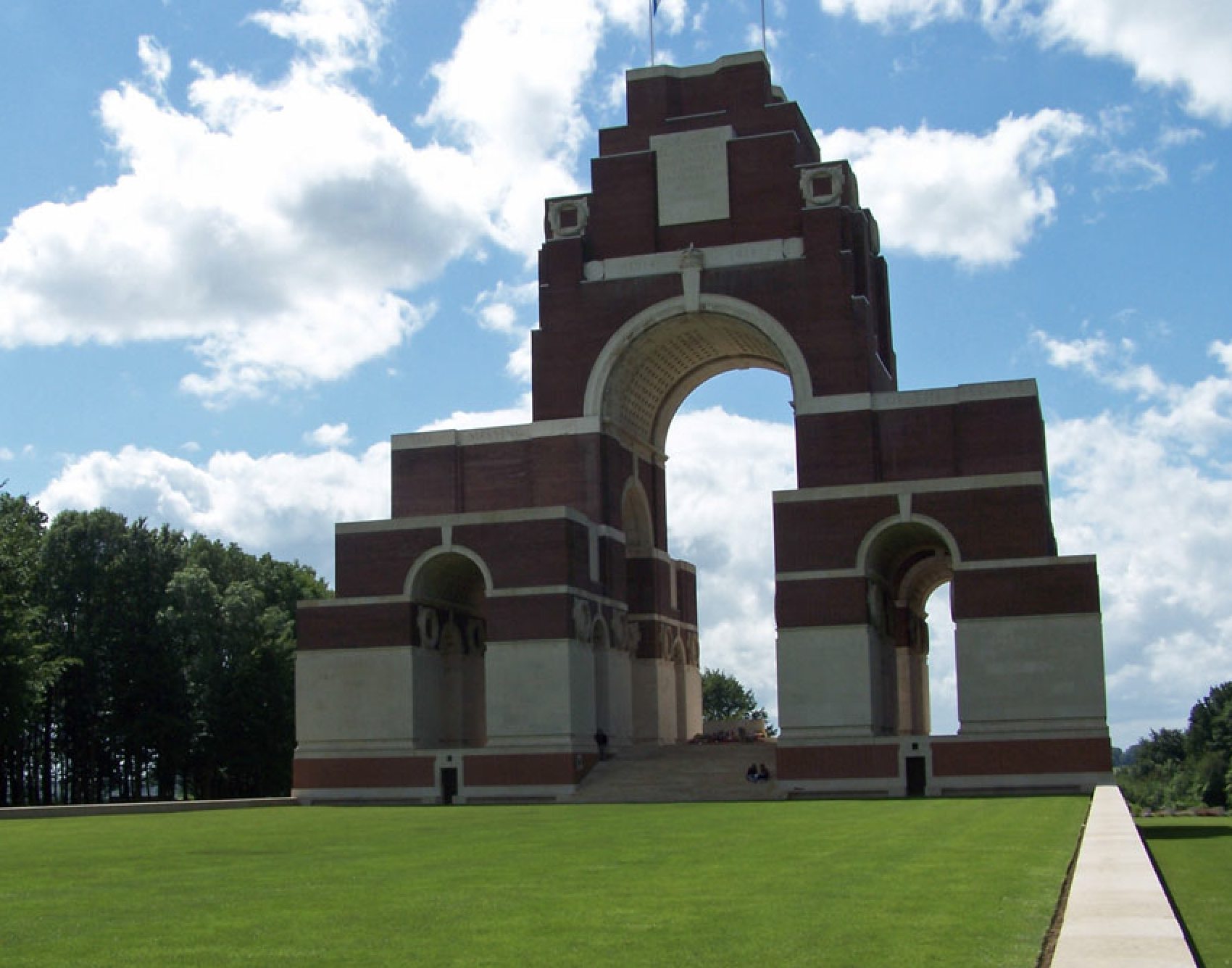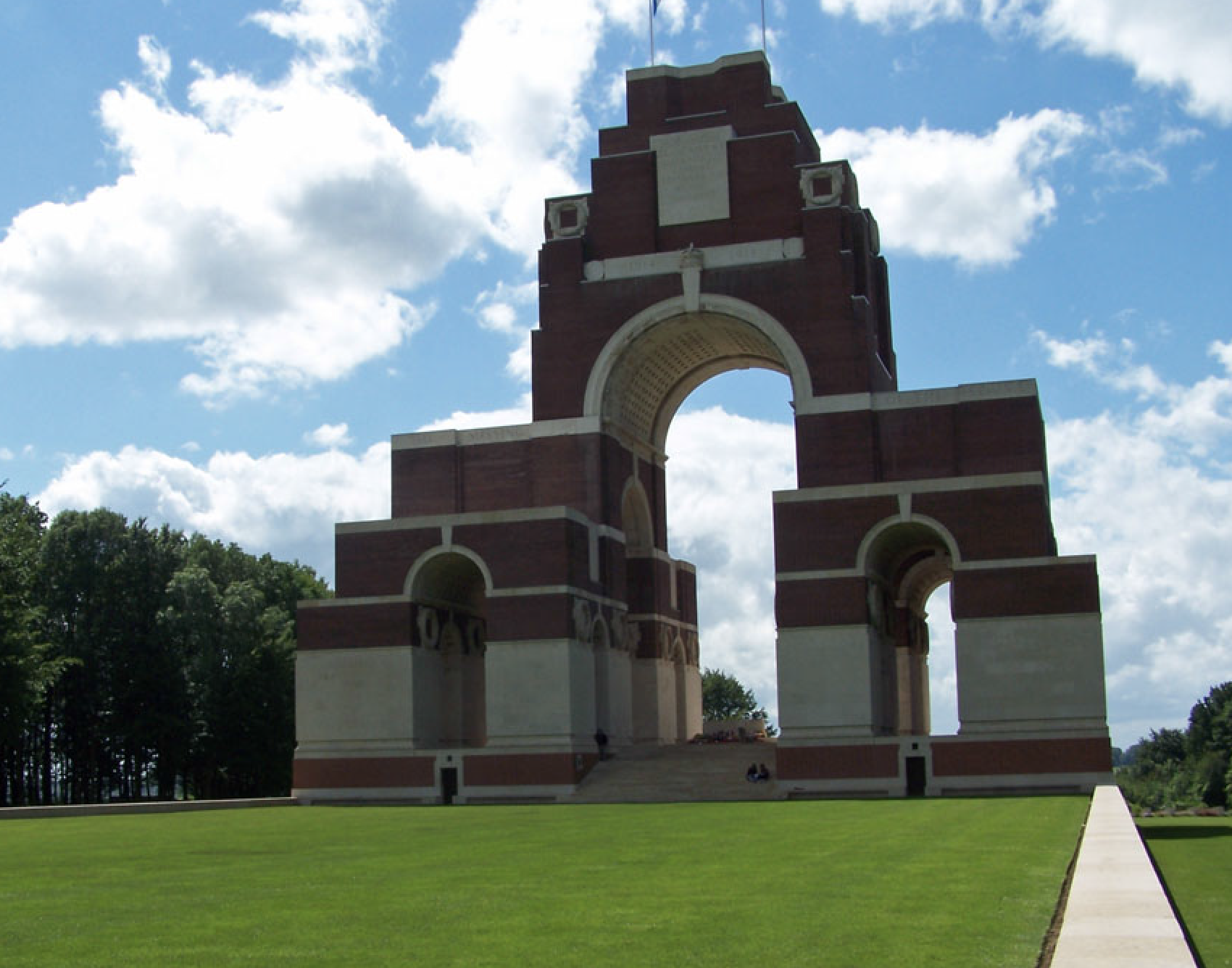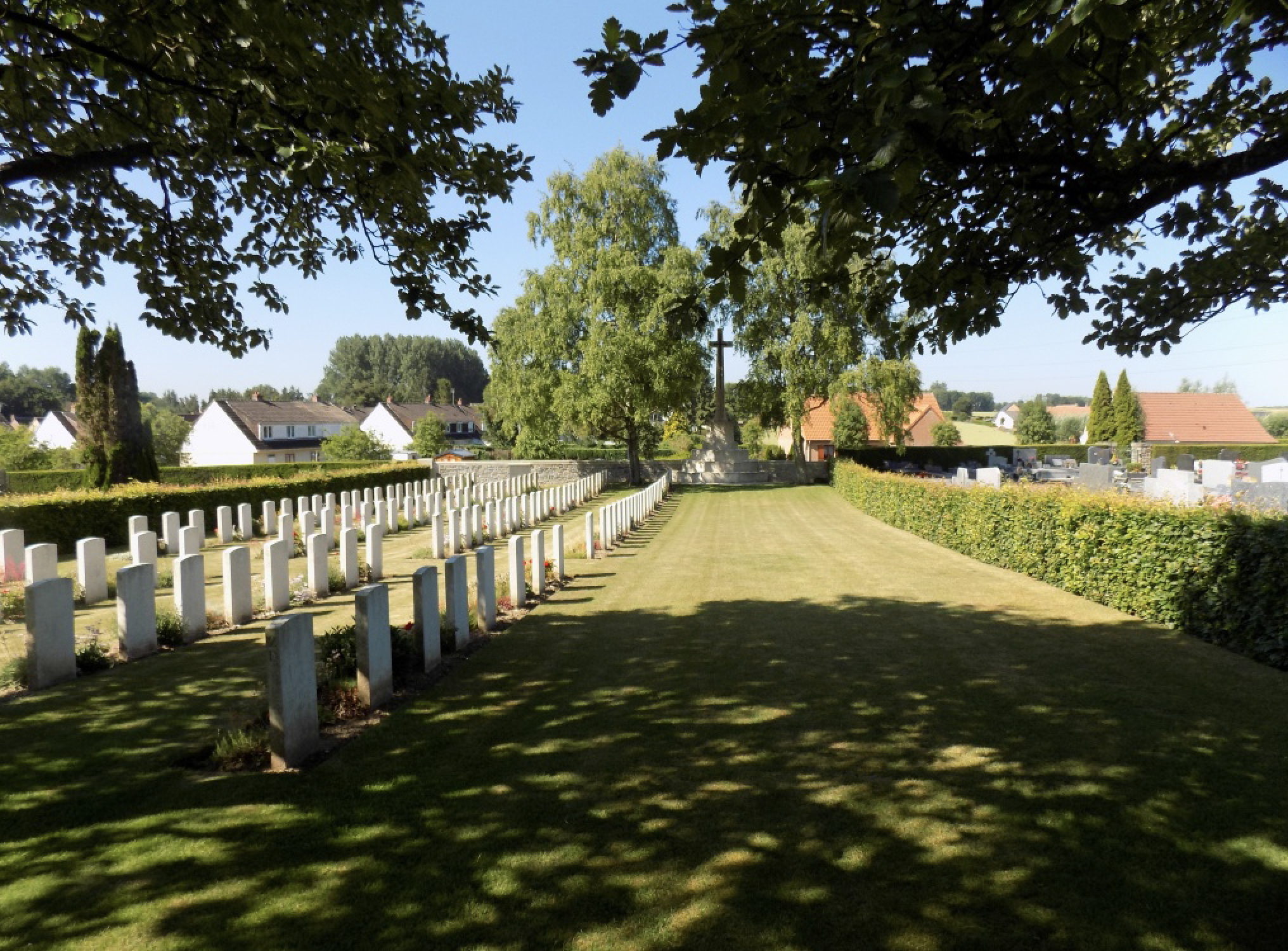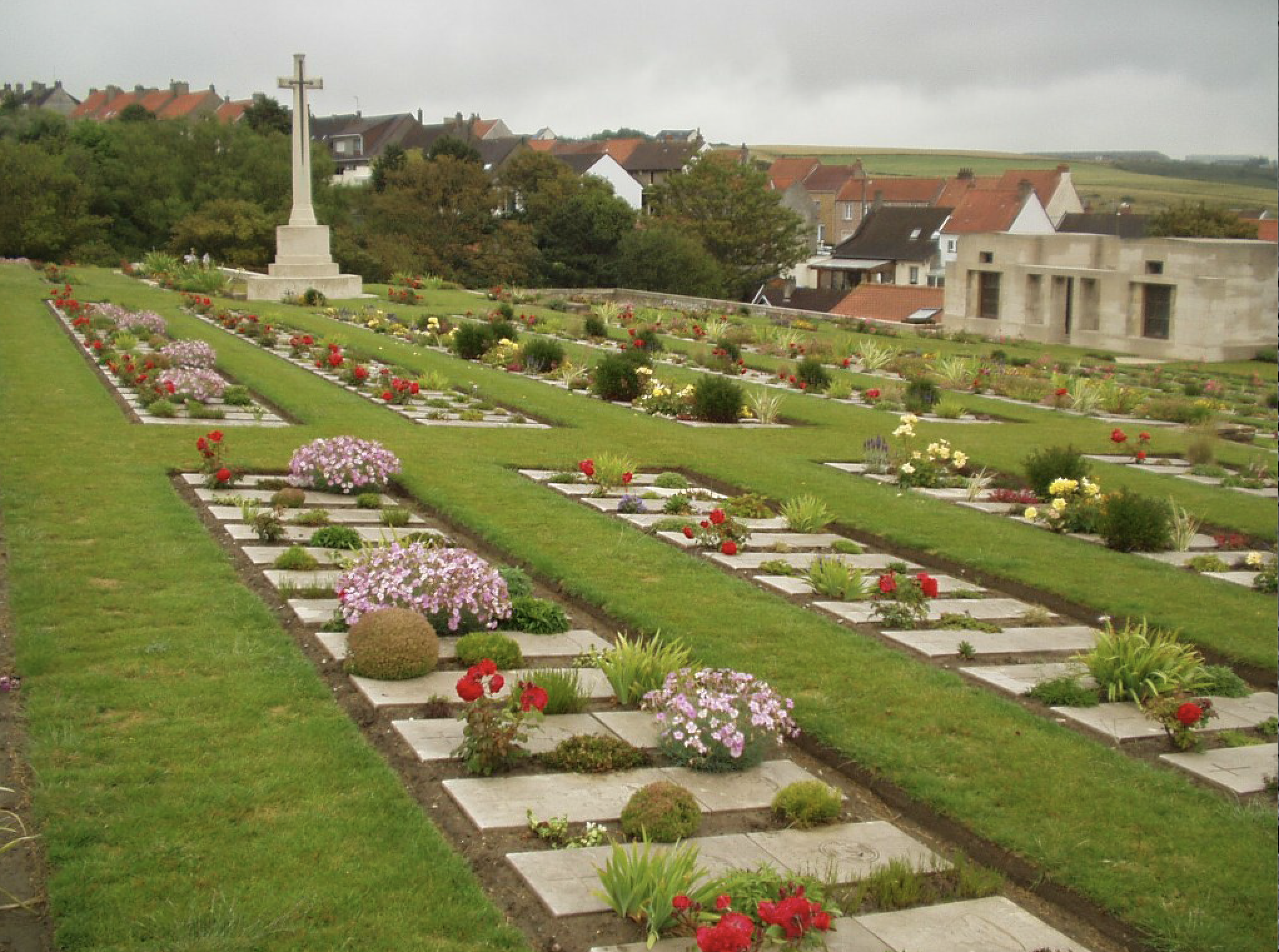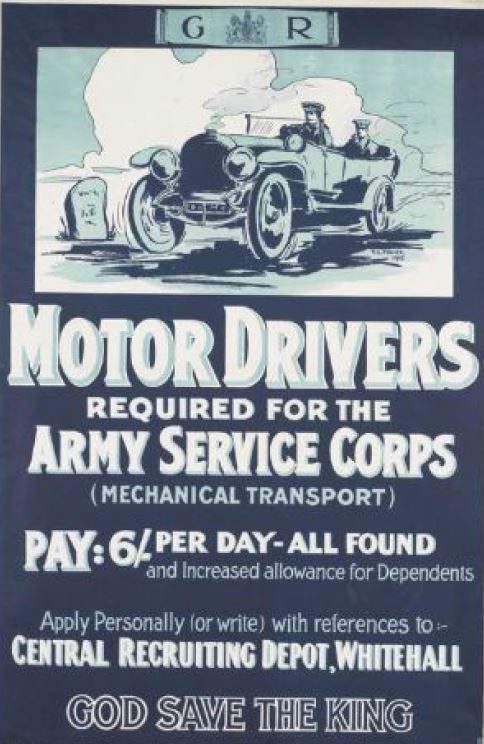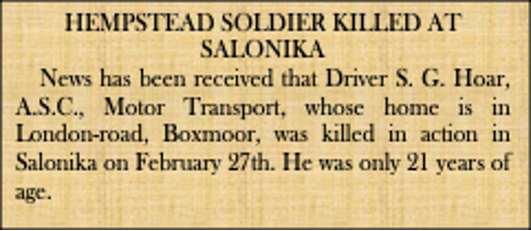Fallen in February 1917:
Walter Webb
Arthur Hucklesby
Alfred Henry Bass
George Dunn
Charles Johnson
Edward Minter
Leonard Sells
Frederick Arnott
Joseph Element
Sidney George Hoar
WALTER WEBB
20463 Lance Corporal
"D" Coy. 4th Bn., Bedfordshire Regiment
Killed in Action Sunday, 4th February 1917
Remembered with Honour, Ancre British Cemetery, Beaumont-Hamel, Somme, France, Grave VIII. F. 21.
Walter Webb was born in Clophill, Bedfordshire on Saturday, 22nd January 1881 the second child and oldest son born to Arthur John Webb and Louisa Brashier. Arthur and Louisa had a large family, even by the standards of the time, and between 1879 and 1903 they produced fifteen children of which five sadly died when young. The children were: Louisa, Walter, Nellie, Emily, Arthur, Ada, Mary Ann, Susan, George, Alice, Daisy, Violet, Annie, Charles and finally Arthur. The children known to have died were; Louisa and Emily in 1891 and Nellie in 1902.
Walter grew up in Clophill and like his father Arthur, he started working as an ‘Agricultural Labourer’ and specifically as a ‘Horse Keeper’. Whilst still living in Clophill, Walter met Jane Emma Elizabeth Maynard and they were married in Bedford in 1905. Almost as soon as they married the couple moved to Leverstock Green in Hertfordshire, possibly because Walter found another farming job and two years later their first child Ethel was born.
By the time of the 1911 census Walter was working at Apsley Paper Mills with John Dickinson & Co Limited and he was recorded as a ‘Collector of Orders’. The young family lived at ‘Belconey’ in Leverstock Green and in 1915, shortly before Walter enlisted, their second child Emily Louisa was born in February.
Walter, Jane and Ethel c 1912
Walter attested at St Alban’s in May 1915 and joined the Bedfordshire Regiment. It is thought that he had tried to enlist previously but had been rejected as ‘unfit’ due to asthma, however on this occasion, he was accepted for service and went to train at Ampthill Depot. During 1915 he served in various stations on home defence duties before going to France in 1916 in time to fight in the Battle of Vimy Ridge on the 9th April.
This was followed by the Battle of the Somme from the 1st July until the last major engagement of the Somme offensive at Ancre, between the 13th and 18th November. It is possible that Walter was wounded at Ancre as he was invalided home before the end of the year.
However, he returned to the Front in 1917 with the 4th Battalion Bedfordshire Regiment and during the first few days of February, the Battalion was engaged in operations in the front-line trenches on the north bank of the River Ancre. It was here that Walter was killed possibly by shell fire from enemy attacks.
He died on Sunday, 4th February 1917.
Walter is commemorated on the Leverstock Green War Memorial.
Walter is Remembered with Honour in Ancre British Cemetery, Beaumont-Hamel, Somme, France where he is interred in Grave VIII. F. 21. The inscription on his headstone, requested by his wife Jane reads: “A LOVING HUSBAND A FATHER KIND A BEAUTIFUL MEMORY LEFT BEHIND”.
He was 36 years old when he died.
Walter was entitled to the British War Medal and the Allied Victory Medal.
Lance Corporal Walter Webb c1915 (Photo:https://sites.google.com/site/leverstockgreenwarmemorial/walter-webb) (Source: Heidi Bustard)
Walter, Jane and Ethel c1912 (Photo:https://sites.google.com/site/leverstockgreenwarmemorial/walter-webb) (Source: Heidi Bustard)
Leverstock Green War Memorial (Photo: Traquair Photography 15th Jun. 2016)
Walter’s grave, Ancre British Cemetery, Beaumont-Hamel, Somme, France (Photo: Traquair Photography 5th Nov. 2017)
ARTHUR HUCKLESBY
6088 Private
1st/4th Bn., York and Lancaster Regiment
Died of Wounds Sunday, 11th February 1917
Remembered with Honour, Warlincourt Halte British Cemetery, Saulty, Pas-de-Calais, France, Grave IV. J. 5.
Arthur James Hucklesby was born on Monday, 28th June 1897 in Harpenden, Hertfordshire and baptised along with his younger brother Stanley on Sunday, 30th March 1902. He was the older of two sons born to George Hucklesby and Eliza Oakley, but he had seven half siblings who were from his father’s first marriage to Eliza Munt. Arthur’s brothers and sisters were: William, Charles, Emma, Jane, George, Henry and Elizabeth. The youngest of his half-sisters was thirty years older than Arthur and the five oldest children where older than their step-mother. His father George died in 1907 aged seventy-eight when Arthur was ten years old.
The family lived in Harpenden when both Arthur and his brother Stanley were born, but moved to Hemel Hempstead after their father’s death. Arthur lived with his mother and brother in Paradise, Hemel Hempstead and it was from here that he went to his new school, Boxmoor JMI, in 1909.
He left school a year later aged thirteen, to start work with G.B. Kent and Sons the Brush makers in Apsley but left their employ shortly afterwards and entered the Navy. His time with the Navy was short however, and by 1913 he had joined John Dickinson & Co. Limited in Apsley Mills where he would remain until joining the Army.
On the outbreak of war, Arthur was still too young to enlist, nevertheless he attested at Hertford and joined the 3rd Battalion Hertfordshire Regiment on the 9th January 1916 when he was aged just seventeen years and seven months old. On enlistment he was "5ft 3¾ins tall with a 32½ inch chest" but still considered fit for military service.
He spent the next year training and on home defence duties before transferring, on the 9th August 1916, to the 6th (Reserve) Battalion Northumbrian Fusiliers when he was eligible for overseas service. He went to France on the 30th August with his new Regiment.
Only nine days after disembarking in France he transferred battalions again, this time to the 1/4th Battalion (Hallamshire) York and Lancaster Regiment which was under the orders of the 148th Brigade in the 49th (West Riding) Division. Almost immediately after joining his Battalion, Arthur saw significant action in the Battle of Flers-Courcelette and through October and November 1916 he fought in the last phase of the Somme offensive at Morval, Thiepval, Transloy and Ancre.
The following February the Battalion was at Bellacourt approximately six miles south west of Arras and during a few ‘quiet’ days at the start of the month, Arthur was wounded in the neck by machine gun fire. He sustained his wounds on the 3rd February and despite being evacuated down the line for treatment, he sadly did not recover.
Arthur died of his wounds on Sunday, 11th February 1917.
On the 9th February Arthur’s sister Elizabeth received a telegram reporting that he was dangerously ill after being wounded. Three days later she telegrammed the Regiment seeking news of his condition and later the same afternoon she received the tragic news of his death.
York and Lancaster Regiment Cap badge WW1 (Photo: Public Domain)
John Dickinson & Co. Limited War Memorial, Apsley (Photo: Traquair Photography 28th Aug. 2016)
Warlincourt Halte British Cemetery, Saulty, Pas-de-Calais, France (Photo: CWGC)
Arthur was commemorated on the John Dickinson & Co. Limited War Memorial in Apsley.
Arthur is Remembered with Honour in Warlincourt Halte British Cemetery, Saulty, Pas-de-Calais, France, where he is interred in Grave IV. J. 5.
He was only 19 years old when he died.
Arthur was entitled to the British War Medal and the Allied Victory Medal.
ALFRED HENRY BASS
26792 Private
6th Bn., Northamptonshire Regiment
Killed in Action Saturday, 17th February 1917
Remembered with Honour, Regina Trench Cemetery, Grandcourt, Somme, France, Sp. Mem. A. 5.
Alfred Henry Bass was born in Hemel Hempstead on Friday, 20th November 1891 the oldest child and only son of Henry Alfred Bass and Sarah Alkins. Henry and Sarah had a total of eight children one of whom died young. The surviving children were: Alfred Henry, Caroline Lydia, Annie Louisa, Bertha Ellen, Gertrude Nellie, Ethel May and Eva Mildred.
The Bass family lived at 15 Horsecroft Road, Boxmoor when Alfred was born, and his father Henry worked as a ‘Checker’ in the Envelope Department at John Dickinson & Co. Limited in Apsley Mills. His mother Sarah worked as a ‘Laundress’.
Living next door to Alfred in 1901 were Harry and William Gamble and three doors further along was Albert Charge. All four of these young boys fell in the Great War; the two Gamble boys six months apart in 1916 and Albert Charge in 1918. Their biographies all appear on this site.
Alfred started at Boxmoor JMI School in 1897, a few months after his sixth birthday, and proceeded to gain five of his seven standards before he left in November 1904 to start work as an ‘Errand Boy’ at a Grocers, no doubt one of the five or so on St John’s Road in Boxmoor.
By 1911 the family had moved to Cotterells in Hemel Hempstead and Alfred, his father and two of his sisters worked at Dickinsons in Apsley. His sixteen-year-old sister Annie worked for G. B. Kent and Sons Ltd in its Brush factory in Apsley. Her job was one of the myriad labour-intensive tasks involved in the manufacture of brushes; namely ‘Machine operator to bore holes for bristles’.
At around this time Alfred met Minnie Elizabeth Dear who lived on London Road, Boxmoor and whom he may already have known from Boxmoor JMI School. Minnie, originally from Putney, became Alfred’s sweetheart and they were married in Hemel Hempstead on Monday, 1st November 1915, a month before he enlisted.
Alfred attested at Hemel Hempstead on 11th December 1915, under the Derby Scheme, and deferred his enlistment until he was called-up on the 10th April 1916. The reason for deferment was probably because he and Minnie were expecting their first child and indeed, little Sydney Alfred Bass came into the world just three weeks after Alfred had joined up on the 29th April 1916.
Alfred enlisted with the 4th Battalion East Anglian Brigade, Royal Field Artillery but transferred to the Northamptonshire regiment and was posted to the 3rd (Reserve) Battalion at Gillingham in Kent to train. He was taller than average for the time at 5ft 7ins, was of fair completion and very slim build weighing just 8st 8lbs. On completion of his training, he was sent to France on the 29th September 1916 and posted initially to the 2nd Battalion Northants, but two weeks later he transferred to the 6th Battalion Northants in the field.
Alfred fought in the third phase of the Battle of the Somme seeing action at Transloy, Ancre Heights and in the last battle on the Somme, the Battle of Ancre. In early 1917 he was with the Battalion near Miraumont north of Thiepval as a planned attack unfolded on the morning of 17th February. The attack was successful but the 6th Northants suffered numerous casualties in reaching its objectives, one of whom was the unfortunate Alfred.
He was killed at some point during the action on Saturday, 17th February 1917.
Minnie was officially notified one month after his death, on the 23rd March 1917. Before he had gone to war Alfred had been an enthusiastic member and bandsman of his local Salvation Army branch in Hemel Hempstead. On Sunday, 1st April 1917 the local Salvation Army Adjutant, Mr England and his wife, conducted a two-part service to commemorate their fallen comrade Alfred. A detailed report in the Hemel Gazette described first, the open-air service followed by a gathering of family, friends and comrades in the Salvation Army Hall. (see extract)
After his death, Alfred’s wife Minnie received a pension of 18s 9d for herself and young Sydney.
He was initially buried about one mile east of Grandcourt and after the war, many of the soldiers killed were exhumed and transferred to the Regina Trench Cemetery. Many including Alfred were not formally identified and are assumed to have been transferred to the cemetery which contains a Special Memorial to commemorate the unidentified men.
Extract from The Hertfordshire, Hemel Hempstead Gazette and West Herts Advertiser 7th Apr 1917
John Dickinson & Co. Limited War Memorial, Apsley (Photo: Traquair Photography 28th Aug. 2016)
Regina Trench Cemetery, Special Memorial, Grandcourt, Somme, France (Photo: CWGC)
He was commemorated on the John Dickinson & Co. Limited War Memorial in Apsley.
Alfred is Remembered with Honour in Regina Trench Cemetery, Grandcourt, Somme, France on Special Memorial A. 5. The inscription on the memorial reads: “THEIR GLORY SHALL NOT BE BLOTTED OUT”.
He was 25 years old when he died.
Alfred was entitled to the British War Medal and the Allied Victory Medal.
GEORGE DUNN
36293 Private
6th Bn., Royal Berkshire Regiment
Killed in Action Saturday, 17th February 1917
Remembered with Honour, Regina Trench Cemetery, Grandcourt, Somme, France, Grave VIII. F. 3.
George Dunn was born in Tring on Friday, 19th December 1890 and was baptised on Wednesday, 4th February the following year along with his older sister Eliza. He was the third child and oldest son born to George Dunn and Alice Herridge who had five children in total who were: Eliza, Mary, George, John and Albert. George also had an older half-sister Ellen born before his mother met and married his father.
George’s father was a ‘Professional Cricketer and Groundsman’, a profession he was still pursuing at the age of 47 in 1911 when he worked at Elstow School in Kempston, Bedford.
George junior moved to the Apsley area some time after 1911 and whilst there he met Olive Sears and in 1915 they were married at Redbourn near St Albans. They had one child together, Frances Georgina Dunn who was born on the 23rd March 1917. Tragically, George and little Frances never knew each other as George was killed just over a month before his daughter was born.
George joined the colours under the Derby Scheme, attesting in Hemel Hempstead and enlisting with the Hertfordshire Regiment. He went to Hertford to train with the 3rd/1st Battalion and six months later George was sent to France around May/June 1916. It is not known whether George was posted to the 1st or 2nd Battalion Hertfordshires, but what is clear is that he transferred to the 6th Battalion Princess Charlotte of Wales’s (Royal Berkshire Regiment).
The 6th Berkshire Regiment was under the orders of the 53rd Brigade in the 18th (Eastern) Division and it was in the vicinity of ‘Regina Trench’, approximately three miles south west of Bapaume in February 1917.
On the morning of the 17th February the 6th Berkshires attacked at 05:40 a.m. and despite a constant German barrage, heavy broken ground and utter darkness, the attack went to plan, and the final objectives were reached. However, the casualties incurred during the actions included George. The Battalion War Diary records casualties on the 17th February as follows: “O.R. Killed 19, O.R. Wounded or Missing 169”.
George was Killed in Action Saturday, 17th February 1917.
George is Remembered with Honour in Regina Trench Cemetery, Grandcourt, Somme, France where he is interred in Grave VIII. F. 3.
He was 26 years old when he died.
George was entitled to the British War Medal and the Allied Victory Medal.
Pte. George Dunn c1916 (Courtesy: The Hertfordshire, Hemel Hempstead Gazette and West Herts Advertiser)
The shell-pocked landscape around Regina Trench (Photo: Library and Archives Canada—C-014151)
Regina Trench Cemetery, Grandcourt, Somme, France (Photo: CWGC)
CHARLES JOHNSON
36365 Private
6th Bn., Royal Berkshire Regiment
Killed in Action Saturday, 17th February 1917
Remembered with Honour, Regina Trench Cemetery, Grandcourt, Somme, France, Grave VII. C. 23.
Charles William Johnson was born in Mill Hill near Hendon in Middlesex in early 1892. He was the oldest child born to William Augustus Johnson and Caroline Letitia Todd who had four children together. Charles’ siblings were: Henry, Walter and Ellen.
When Charles was born his family lived at 2 Highwood Cottages in Mill Hill and his father William worked as a ‘Carter’ on a nearby farm. At some point before 1911, Charles moved with his family to Hemel Hempstead where they lived at 2 Adeyfield Terrace in a house known as ‘The Firs’.
By this time his father worked as a ‘Domestic Gardener’ and Charles and his brothers were all in employment. Charles worked as a ‘Farm Labourer’; his brothers Henry and Walter were a ’Dairy Hand’ and ‘Mill Hand’ respectively; whilst his sister Ellen was still at school.
Before the outbreak of war, Charles went to work for John Dickinson & Co. Limited at Apsley Mills where his brother Walter was already employed. He remained there until the second year of the war when he joined the Colours.
He attested at Hemel Hempstead in September 1915 a month before the introduction of the Group Scheme popularly known as the Derby Scheme. Charles enlisted with the Hertfordshire Regiment and was embodied in October and sent to the 1/1st Battalion the ‘Hertfordshire Guards’ as it was known.
Records do not reveal when Charles went to France or whether he had transferred to the 6th Battalion Princess Charlotte’s (Royal Berkshire) Regiment before he went, but either way he most probably disembarked in France in May or June of 1916 after six months of training in England.
What is known is that in February 1917, the 6th Battalion Berkshire Regiment was under the orders of the 53rd Brigade in the 18th (Eastern) Division and it was in the vicinity of ‘Regina Trench’, approximately three miles south west of Bapaume. By the 15th of the month it was making preparations for an attack two days later.
‘Regina Trench’ had been the longest trench in the German fortifications in the whole of the First World War, and it had been captured by the Allies in October 1916. It was gained with heavy losses, particularly by the 2nd and 3rd Canadian Divisions. They had suffered 9,499 killed, wounded or missing during efforts to capture ‘Regina’ and this included 1,364 casualties on the 8th October alone.
Charles went into action with the 6th Berkshires at 05:40 a.m. on the morning of the 17th February and despite a constant German barrage, heavy broken ground and utter darkness, the attack went to plan, and the final objectives were reached. However, the casualties incurred during the actions included Charles. The Battalion War Diary records casualties from the 17th to 28th February as follows: “Killed 20, Wounded 122, Missing 48”.
It is not clear at which stage of the attack Charles fell but he was killed on Saturday, 17th February 1917.
Regina Trench Operations 1916-17 (Image: Public Domain)
Regina Trench Cemetery, Grandcourt, Somme, France (Photo: CWGC)
Charles was eventually buried in Regina Trench Cemetery which was a “concentration cemetery” where the mortal remains of many men were brought in from scattered graves and small battlefield cemeteries around Courcelette, Grandcourt and Miraumont.
Unlike many CWGC cemeteries, where men are laid one-to-a-grave, many of the graves contain more than one burial and two names are shown on some of the headstones. The Cemetery is located approximately midway between the villages of Grandcourt and Courcelette.
Charles is Remembered with Honour in Regina Trench Cemetery, Grandcourt, Somme, France where he is interred in Grave VII. C. 23.
He was 25 years old when he died.
Charles was entitled to the British War Medal and the Allied Victory Medal.
EDWARD MINTER
50400 Private
11th Bn., Royal Fusiliers
Killed in Action Saturday, 17th February 1917
Remembered with Honour, Thiepval Memorial, Somme, France, Pier and Face 8 C 9 A and 16 A
Edward Burden Minter was born in Penge, London on Saturday, 11th April 1891 and baptised four months later on Sunday, 2nd August in Bovingdon, Hertfordshire. He was the second child and first son born to Edward Burden Minter and Joanna Seabrooke who had ten children together, two of whom died in infancy. The surviving children were: Edith Joanne, Edward Burden, Mabel Emily, Kate Frances, Alice Avis, Albert, Florence Ethel and George Thomas.
Edward’s father Edward was a native of Hoxton in London and was living in Penge near Croydon as a ‘House Painter’ when his eldest son was born. Two years later, the family moved to Bovingdon in Hertfordshire where Edward’s mother Joanna had been born and where she still had family.
By the time he was twenty-years-old, Edward was working as a ‘Builder’s Carter’ and at around this time he met Emily Florence Lee who lived in Adeyfield in Hemel Hempstead. Emily worked for G.B. Kent and Sons Ltd. as a ‘Hand Drawer’ in the brush works in Apsley.
In 1913 Edward and Emily were married on 15th November in St Paul’s Church, Hemel Hempstead where Emily and her family were members of the congregation. The young couple moved into Emily’s parents house at 5 Adeyfield Cottages and Edward’s family also moved from Bovingdon to Cowper Road in Boxmoor.
Edward joined the Colours under the Military Service Act which had introduced conscription in January 1916 and came into full effect two months later in March. Edward attested in Hemel Hempstead in the same month and joined the Royal Fusiliers (City of London) Regiment and immediately went to undergo basic training.
When he went to France on the 28th September 1916 he was initially posted to the 26th Battalion. He saw his first action at the Battle of Transloy Ridges and just as it concluded he was transferred to the 11th Battalion Royal Fusiliers.
Edward immediately went into action with his new Battalion at the final engagement on the Somme in the Battle of Ancre. In early 1917 the Battalion was engaged in operations along the Ancre and by February had moved to Miraumont where an attack on the German positions was in preparation on the 15th February. Two days later Edward went into action again when the attack began at 05:45 a.m. on what would prove to be his last day of life.
The advancing troops ran into heavy sniping and machine gun fire which resulted in every company officer being killed or wounded before they had even reached the German Trench a short distance away. The accuracy of the enemy fire was noted in the Battalion War Diary which records the following: “Throughout the Operation it was remarkable the high percentage of men that were hit through the head, showing beyond a doubt that these Germans who had to meet us were no mean marksmen”
The majority of the Battalion casualties appear to have been incurred during the early part of the assault and again the War Diary recorded the following: “2 Officers Killed, 1 Officer Died of Wounds, 11 Officers Wounded, 1 Officer Shell Shock 36 OR Killed in action, 6 OR Died of Wounds 162 OR Wounded 69 OR Missing”
Edward was one of the men Killed in Action and he died on Saturday, 17th February 1917.
He was commemorated on a memorial plaque in St Paul’s Church in Hemel Hempstead.
Edward is incorrectly recorded as ‘F Minter’ on the Hemel Hempstead War Memorial.
Royal Fusiliers (City of London) Regiment WW1 Cap Badge (Photo: Public Domain)
St. Paul's Church, Highfield, Hemel Hempstead, Memorial Scroll (Photo: Traquair Photography)
Thiepval Memorial, Somme, France (Photo: CWGC)
Edward is Remembered with Honour on the Thiepval Memorial, Somme, France, Pier and Face 8 C 9 A and 16 A.
He was 25 years old when he died.
Edward was entitled to the British War Medal and the Allied Victory Medal.
LEONARD SELLS
43231 Private
6th Bn., Northamptonshire Regiment
Killed in Action Saturday, 17th February 1917
Remembered with Honour, Thiepval Memorial, Somme, France, Pier and Face 11 A and 11 D
Leonard Sells was born in Hemel Hempstead in early 1889 and baptised in St Paul’s Church in the town on Sunday, 17th March in the same year. He was the second son born to Harry (Henry) Sells and Ann Parkins and he had five siblings one of whom had died at birth. His surviving brothers and sisters were: Bert (Herbert), Sidney, Kate and Albert.
The Sells family lived in Union Street in Hemel Hempstead when Leonard was born; indeed, his mother Ann had been born just around the corner in Chapel Street and she lived within 100 yards of her birthplace until she died.
Leonard’s father Harry was a ‘Labourer’ for his whole working life either on farms or with bricklayers in the building trade.
By 1911 all the members of Leonard’s family, with the exception of his mother, were in employment. His father and older brother Bert worked in the building trade, Leonard worked with John Dickinson & Co. Limited as a ‘Paper Puncher’, his brother Sidney worked for the Hemel Gazette as a ‘Printer’, his sister Kate was a ‘French Polisher’ of brush handles at G.B. Kents & Sons Ltd in Apsley and his youngest brother was a ‘Millhand’ at Dickinsons.
Leonard enlisted in February 1916 just before the introduction of conscription and after attesting at Hemel Hempstead he joined the Bedfordshire Regiment and was posted to the 8th (Service) Battalion to begin training at the vast ‘New Army’ training area around Woking.
He went to France around August 1916 and saw action in the Battle of Flers-Courcelette before he was transferred to the 6th Battalion Northamptonshire Regiment. He then fought in the Battles of Transloy, Ancre Heights and the final engagement of the Somme offensive at Ancre.
In early 1917 he was with the Battalion near Miraumont north of Thiepval as a planned attack unfolded on the morning of 17th February. The attack was successful but the 6th Northants suffered numerous casualties in reaching its objectives, one of whom was the unfortunate Leonard.
Leonard was killed at some point during the action on Saturday, 17th February 1917.
He was commemorated on a memorial plaque in St Paul’s Church in Hemel Hempstead and on the John Dickinson & Co. Limited War Memorial in Apsley.
Northamptonshire Regiment Cap Badge WW1 (Image: Public Domain)
John Dickinson & Co. Limited War Memorial (Photo: Traquair Photography 28th Aug. 2016)
Thiepval Memorial, Somme, France (Photo: CWGC)
Leonard is Remembered with Honour on the Thiepval Memorial, Somme, France, Pier and Face 11 A and 11 D.
He was 28 years old when he died.
Leonard was entitled to the British War Medal and the Allied Victory Medal.
FREDERICK ARNOTT
6936 Private
7th Bn., Royal Sussex Regiment
Died of Wounds Monday, 19th February 1917
Remembered with Honour, Avesnes-Le-Comte Communal Cemetery Extension, Pas-de-Calais, France, Grave IV. B. 14.
Frederick Thomas Arnott, was born in Roehampton, Surrey on Monday, 20th August 1883. He was the youngest child born to George Arnott and Emma Why who had a family of six children who were; Anne Rebecca, William, Alice Mary, Sarah Jane, Martha and Frederick Thomas. William died at birth in 1875, whilst Martha and her father George both died in 1901 aged twenty and fifty-two respectively.
In 1901 when he was seventeen-years-old, Frederick worked at Grove House in Roehampton as a ‘Gardener’. Grove House was built in 1777 and had extensive gardens when Frederick worked there, one of fourteen servants employed at the house and gardens recorded on the Census return that year.
Young Frederick met his future wife Maria Pick, a native of Gloucester and a ‘Domestic Servant, when she came to the Roehampton area to work, possibly at Grove House. They married in 1906 in Chelsea and a year later the first of their four children was born; a boy whom they christened William Frederick. Their other children were; George Edward in 1908, Lorna Edith in 1909 and finally Miriam Alice in 1912.
All four children were born in different locations indicating that Frederick and Maria moved frequently, presumably to take up new positions. They finally settled in Petworth in Sussex where it is likely that one or both parents worked at Petworth House and Gardens.
It was from here that Frederick went to join the Colours, attesting at Eastbourne in June 1915 and enlisting with the Royal Sussex Regiment. He went to Colchester to train and six months later he was sent to France where he was posted to the 7th (Service) Battalion Royal Sussex Regiment.
Frederick fought in the Battle of Albert which included the capture of the following towns; Montauban, Mametz, Fricourt, Contalmaison and La Boisselle. He was at the Battle of Pozières in late July and fought for Mouquet Farm where the ANZAC forces lost over 6,500 men in twelve days. In October 1916 Frederick saw action in the Battle of Transloy which included the successful capture of Eaucourt l’Abbaye and Le Sars
By the 12th February 1916, Frederick was with the Battalion in the trenches opposite Hohenzollern Redoubt at Auchy-les-Mines near Loos. Over the next eight days the 7th Sussex exchanged artillery bombardments and sniping with the enemy. The Battalion War Diaries recorded casualties on only two of those days, the 13th and 15th February and it was on one of these dates that Frederick was wounded. He was taken down the line to a Casualty Clearing Station for treatment but to no avail.
Frederick died of his wounds on Monday, 19th February 1917.
It is unclear why Frederick is commemorated on the Hemel Hempstead War Memorial as research has failed to reveal any link with the town or surrounding area. It may be that one of his sisters moved to the town and put his name forward for inclusion.
Frederick is Remembered with Honour in Avesnes-Le-Comte Communal Cemetery Extension, Pas-de-Calais, France where he is interred in Grave IV. B. 14.
He was 33 years old when he died.
Frederick was entitled to the British War Medal and the Allied Victory Medal.
Grove House in 1921 (Photo: University of Roehampton)
Royal Sussex Regiment Cap Badge WW1 (Image: Public Domain)
Avesnes-Le-Comte Communal Cemetery Extension, Pas-de-Calais, France (Photo: CWGC)
JOSEPH ELEMENT
23699 Private
4th Bn., Bedfordshire Regiment
Died of Wounds Wednesday, 21st February 1917
Remembered with Honour, Wimereux Communal Cemetery, Pas de Calais, France, Grave II. E. 1.
Joseph Element, known as Joe, was born in Chipperfield near Kings Langley in late Spring 1882 and baptised at Chipperfield Parish Church on Sunday, 2nd July in the same year. He was the second son born to John Element and Sarah Biggs who had a total of six children together who were: William, Joseph, George, Mary, John and Alfred. William died as a teenager and Joe’s father John died in 1891 aged forty-four, leaving Sarah to raise a young family. Joe’s brother George also served in the Great War with the Royal Field Artillery and although severely gassed, he survived the conflict.
When Joe was born his family lived on Bucks Hill, Chipperfield where his father and older brother William worked as ‘Agricultural Labourers’. In 1901 nineteen-year-old Joe and his seventeen-year-old brother George worked as ‘Horsemen’ on a local farm and his widowed mother Sarah had moved the family to 63 Chapel Street in Hemel Hempstead.
By the time he reached his twentieth birthday, Joe and his three younger brothers all worked as ‘Agricultural Labourers’ and lived at home with their mother Sarah. Shortly after the census was taken in 1911 the Element family moved once more, this time to 11 Two Waters Road in Boxmoor and it was from here that Joe joined the Colours.
He enlisted in December 1915 under the Derby scheme, attesting at Bedford where he joined the Bedfordshire Regiment. He was posted immediately to the 4th Battalion at Felixstowe to undergo basic training before being sent to France in 1916. After the disaster on the Somme in July 1916, the 4th Battalion was mobilised and landed in France on the 25th July where it came under the orders of the 190th Brigade in the 63rd (Royal Naval) Division.
Joe fought in the Battle of Ancre in November 1916 after which the 4th Battalion continued with operations in the area until early February 1917. Between the 6th and 16th February the Battalion was in action at Miraumont and over ten days, took part in heavy fighting with the enemy. Casualties were high and the 4th Bedfordshires War Diary recorded the following: “6-16 Feb 1917 Casualties Killed 68. Wounded 90. Missing 3. Missing believed Killed 45.”
Joe was amongst the ninety wounded men and despite being taken down the line for treatment, he succumbed to his wounds and died on Wednesday, 21st February 1917.
Joe is Remembered with Honour in Wimereux Communal Cemetery, Pas de Calais, France where he is interred in Grave II. E. 1. The inscription on his headstone, requested by his mother Sarah, reads: “GONE BUT NOT FORGOTTEN PEACE PERFECT PEACE”.
He was 34 years old when he died.
Joe was entitled to the British War Medal and the Allied Victory Medal.
Bedfordshire Regiment Cap Badge pre-1919 (Image: Public Domain)
Water mill on the Ancre at Miraumont March 1917 (Photo: IWM)
Wimereux Communal Cemetery, Pas-de-Calais, France (Photo: CWGC)
SIDNEY GEORGE HOAR
DM2/169136 Private
605th Mechanical Transport Coy., Royal Army Service Corps
Died of Wounds Tuesday, 27th February 1917
Remembered with Honour, Salonika (Lembet Road) Military Cemetery, Greece, Grave 894
Sidney George Hoar was born in Hemel Hempstead in 1896 the third of five sons born to Harry (Henry) Hoar and Mary Elizabeth Kentish. Sidney’s siblings were Harry, Albert, Reginald and Claude.
When Sidney was born, his father Harry worked as a ‘House Painter’ and the family lived at 103 Marlowes in Hemel Hempstead. His mother Mary was a ‘Dressmaker’, a trade she still plied in 1911 by which time, Sidney’s father had become a ‘Fishmonger’ and ran a shop at 89 Marlowes. Sidney’s brothers Albert and Reginald were a ‘Plumber’ and ‘Painter respectively, whilst Sidney worked as a ’Tinman’ making tinplate goods. His Uncle Walter Kentish who lived with the family was a ‘Cheesemonger’.
Sidney enlisted in March 1916, attesting at Hemel Hempstead and joining the Army Service Corps (ASC). He was posted to the 605th Mechanical Transport Company as a ‘Mechanical Transport Learner’ hence his service number prefix ‘DM2’.
The British Army was the most mechanised of all in the Great War when it came to using motor vehicles for transport. All Mechanical Transport Companies were part of the ‘Lines of Communication’ and were not under orders of a Division, although some (unusually known as Divisional Supply Columns and Divisional Ammunition Parks) were in effect attached to a given Division and worked closely with it.
Those in the ‘Lines of Communication’ operated in a wide variety of roles, such as attachments to the heavy artillery as Ammunition Columns or Parks, Omnibus Companies, Motor Ambulance Convoys, or Bridging and Pontoon units. The ASC was the forerunner of the modern day ‘Logistics Corps’.
Sidney went as a Driver with the 605th Company to Salonika, one of the entry points to the Balkan theatre of war, at some time in late 1916. He went there as part of the support units for The British Salonika Force (BSF) (also known as the British Salonika Army) which was commanded by Lieutenant General George Milne from May 1916.
At its height, in late 1916 to early 1917, it comprised six infantry divisions, grouped into two corps, which were; XII Corps: 22nd, 26th, 60th Divisions and XVI Corps: 10th, 27th, 28th Divisions.
The Salonika Campaign was perhaps the most diverse of the First World War. By 1917, the Allies fielded 600,000 men in six national contingents: British, French, Greek, Italian, Russian and Serbian. Within the British and French forces were units from India, Indo-China, North and West Africa. At peak strength the British Salonika Force (BSF) numbered more than 228,000 officers and men. Admissions to sick lists during the campaign, because of malaria, numbered some 160,000 men, many of who succumbed or had their health ruined.
It is not known how Sidney died but he was officially recorded ‘Killed in Action’ on Tuesday, 27th February 1917.
His death was briefly reported in the Hemel Gazette shortly after he was killed. (see extract)
Sidney is Remembered with Honour in Salonika (Lembet Road) Military Cemetery, Greece where he is interred in Grave 894.
He was only 21 years old when he died.
Sidney was entitled to the British War Medal and the Allied Victory Medal.
ASC Recruitment Poster World War 1 (Image: IWM)
Extract from The Hertfordshire, Hemel Hempstead Gazette and West Herts Advertiser 17th Mar. 1917
Salonika (Lembet Road) Military Cemetery, Greece (Photo: CWGC)
